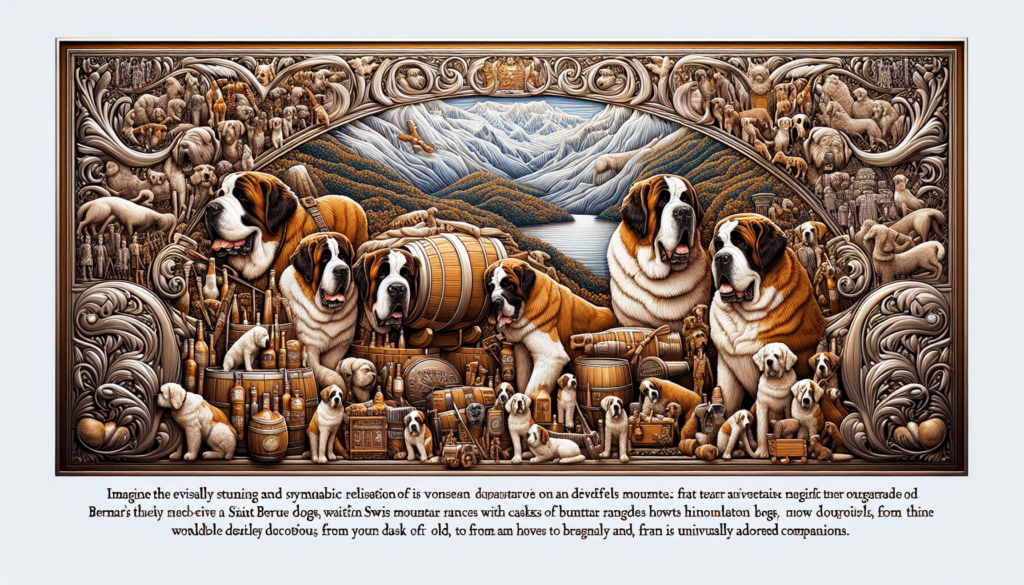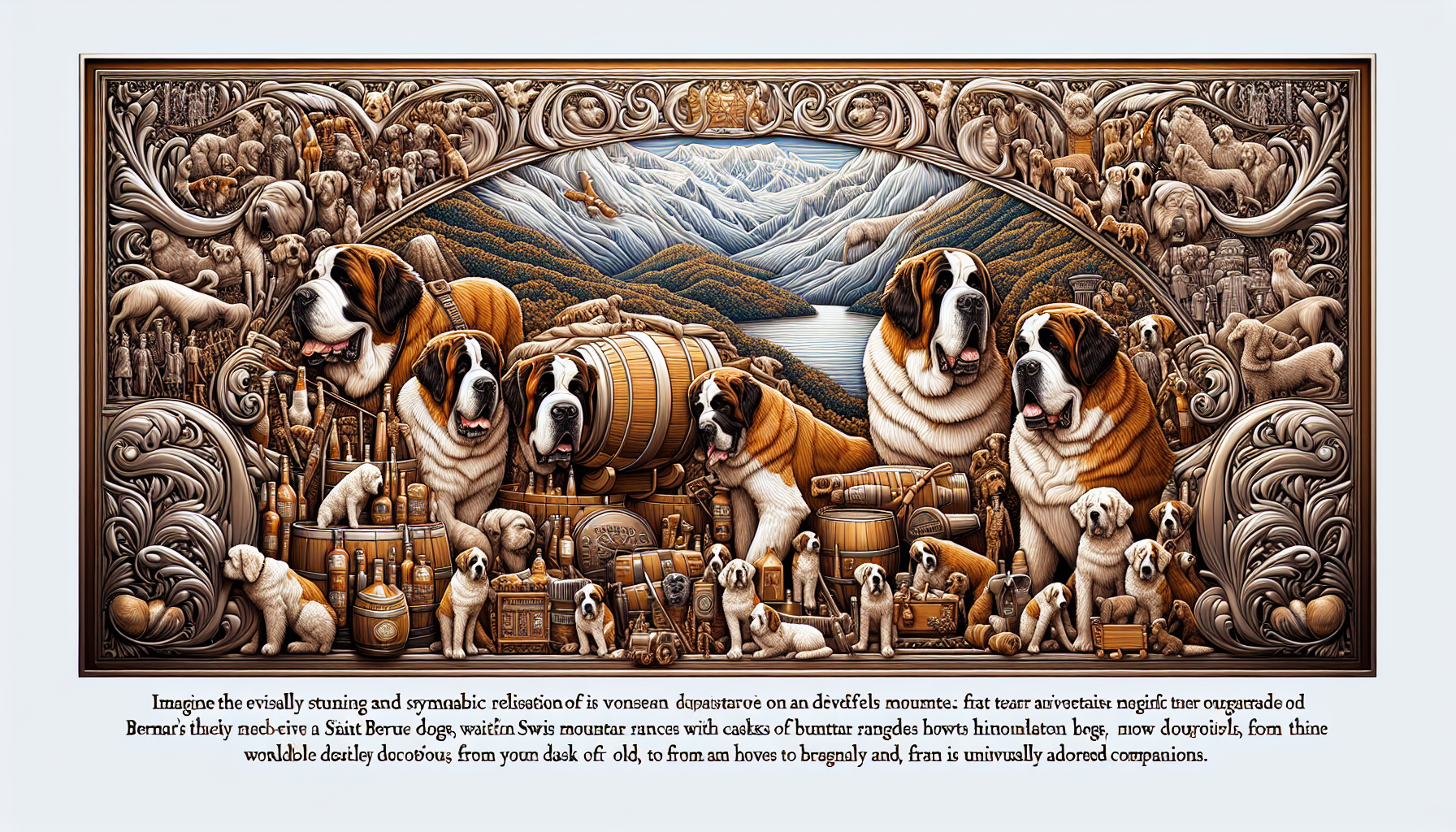Interested in learning about the fascinating origins and history of Saint Bernards? Look no further! In this article, we will provide you with a brief overview of where these beloved and gentle giants originated from, tracing their roots back to the beautiful Swiss Alps. From their humble beginnings as rescue dogs to their popularity as loyal companions today, discover the remarkable journey of Saint Bernards through time. So, grab a cozy spot and prepare to be captivated by the captivating history of these amazing canine companions!
Origins of Saint Bernards
Breed’s Ancestry
The Saint Bernard breed has a fascinating and rich history that dates back several centuries. Despite various theories, the exact ancestry of the Saint Bernard remains a topic of debate among experts. However, it is widely believed that the breed originates from the ancient Molossian dogs that accompanied the Roman armies during their conquests. These powerful and agile dogs were eventually brought to the Swiss Alps, where they were crossbred with local mountain dogs.
The Hospice of St. Bernard
One of the most significant contributions to the development of the Saint Bernard breed was made by the Hospice of St. Bernard. The hospice, located high in the Swiss Alps, served as a refuge for travelers and pilgrims making their way through treacherous mountain passes. Dogs were initially kept at the hospice for protection and to aid in the daily tasks. Over time, they became highly skilled in rescuing stranded or lost individuals in the harsh alpine conditions.
Famous Rescues
The Saint Bernards gained widespread recognition due to their impressive rescue efforts. Countless tales have been told of these heroic dogs braving the treacherous mountains to find and save lost or injured travelers. One of the most renowned Saint Bernards, Barry, is said to have saved over 40 lives during his time at the hospice. These incredible stories of bravery and loyalty helped to establish the Saint Bernard as a symbol of strength and resilience.
Evolution and Development
Early Breeding Practices
In the early years, breeding practices for Saint Bernards were focused primarily on preserving the breed’s working abilities and physical attributes. The primary goal was to produce dogs that were capable of withstanding the harsh alpine conditions and excelling in search and rescue operations. As such, breeding was carefully managed to ensure that only dogs with the desired characteristics were selected for further breeding.
Crossbreeding for Improvement
Over time, breeders sought to improve certain traits of the Saint Bernard through crossbreeding with other breeds. One notable example is the introduction of the Newfoundland breed to enhance the Saint Bernard’s swimming abilities. This crossbreeding resulted in the development of Saint Bernards with larger frames and stronger swimming skills, making them even more effective in water rescues.

Characteristics and Traits
Physical Appearance
Saint Bernards are known for their impressive size and strength. Males typically weigh between 140 and 180 pounds, while females range from 120 to 140 pounds. These gentle giants have a muscular build, broad heads, and expressive eyes. Their fur is dense and can be either smooth or rough, providing protection from the harsh alpine climate. The breed’s trademark feature is its deeply wrinkled face, which adds to its unique and endearing expression.
Temperament
Despite their imposing size, Saint Bernards are renowned for their gentle and friendly nature. They are known to be patient, loyal, and excellent with children, earning them the reputation of being “nanny dogs.” These affectionate companions are highly sociable and thrive on human interaction. Their calm demeanor and natural instinct to protect make them ideal family pets and therapy dogs.
Working Abilities
The Saint Bernard’s working abilities are rooted in their long history as rescue dogs. They possess an exceptional sense of direction and an uncanny ability to navigate treacherous mountain terrain. With their keen sense of smell, they can detect lost or injured individuals buried beneath avalanches, leading to many successful rescue missions. Although their rescue duties have diminished over time, their instinctive skills and work ethic continue to be admired and put to use in various capacities.
Popularity and Recognition
Early Recognition
The heroic feats of the Saint Bernards did not go unnoticed, and they quickly gained recognition both in Switzerland and beyond. Their reputation as dependable and brave working dogs garnered attention and admiration worldwide. While many people were initially drawn to the breed for their rescue abilities, they soon realized that Saint Bernards had much more to offer as loyal companions and family pets.
Popularity as a Pet
Today, Saint Bernards are highly sought-after pets due to their gentle nature, loyalty, and suitability for families. Their patient demeanor makes them excellent with children, and their size often earns them the nickname “gentle giants.” Despite their imposing appearance, they have a friendly and amiable disposition, making them a popular choice for those seeking a loving and devoted companion.
Breed Recognition
The Saint Bernard breed gained formal recognition in the late 19th century. The Swiss Kennel Club officially recognized the breed in 1884, and shortly after, the Saint Bernard Club of America was formed to promote and protect the breed’s interests in the United States. Today, the Saint Bernard is recognized by major kennel clubs worldwide, affirming its status as a distinct and cherished breed.

Breed Standards and Variations
Standardized Breed Characteristics
To maintain the integrity of the breed, specific standards have been established to guide breeding and ensure consistency in Saint Bernard characteristics. These standards outline the ideal size, physical appearance, temperament, and other essential traits of the breed. Breeding programs adhere to these standards to preserve the breed’s unique qualities and uphold its distinctive heritage.
Different Variations of Saint Bernards
While the Saint Bernard breed as a whole possesses certain shared characteristics, there are several variations within the breed. These variations are primarily distinguished by coat type. The two main coat types are smooth and rough. Smooth-coated Saint Bernards have shorter, flat fur, while rough-coated Saint Bernards have a longer, denser, and slightly wavy coat. Both varieties can be found within the breed and are equally prized for their beauty and temperament.
Health Concerns and Care
Common Health Issues
Like all dog breeds, Saint Bernards are prone to certain health issues, and responsible breeders work diligently to reduce the prevalence of these conditions. Some of the health concerns associated with the breed include hip and elbow dysplasia, heart problems, and eye issues. Regular veterinary check-ups, a nutrient-rich diet, and appropriate exercise can help minimize the risk of these ailments and ensure the overall well-being of these gentle giants.
Proper Care and Exercise
Given their size, Saint Bernards require regular exercise to maintain good physical and mental health. Daily walks and access to a secure outdoor area for play are essential. However, it’s vital to avoid excessive exercise, especially during the puppy stage, as their growing bones and joints can be susceptible to injury. Additionally, Saint Bernards benefit from mental stimulation and social interaction, so engaging in activities such as obedience training or interactive play is highly encouraged.
Nutrition and Grooming
Proper nutrition is crucial in maintaining the overall health and longevity of Saint Bernards. A balanced diet that meets their specific nutritional needs, particularly during their growth stages, ensures optimal development and helps prevent obesity, a common concern for the breed. Alongside a nutritious diet, regular grooming is necessary to keep their coats healthy and free from tangles or matting. Brushing their fur and cleaning their ears regularly is essential to maintain good hygiene and prevent any potential skin issues.
Famous Saint Bernards
Barry
Barry, one of the most famous Saint Bernards, served at the Hospice of St. Bernard in the early 1800s. His heroic rescue efforts were unparalleled, and he is credited with saving the lives of numerous stranded travelers in the Swiss Alps during his career. Barry’s legacy lives on even today, as his story continues to inspire and demonstrate the remarkable abilities and compassionate nature of Saint Bernards.
Buck
Fictional but equally renowned, Buck was the protagonist in Jack London’s beloved novel, “The Call of the Wild.” Although not an actual Saint Bernard, Buck’s character captivated readers, showcasing the breed’s strength, loyalty, and adaptability in challenging environments. Through Buck’s adventures, readers gained a newfound appreciation for the remarkable qualities of the Saint Bernard breed.
Palmerston
Palmerston, a lovable Saint Bernard, gained fame in recent times as the “Chief Mouser” of the Foreign and Commonwealth Office in the United Kingdom. Despite his reputation as a dignified and sophisticated diplomat, Palmerston delighted visitors and staff with his friendly and approachable nature. His presence brought joy and a touch of whimsy to the often-serious world of international affairs.
Saint Bernards in Popular Culture
Movie and TV Appearances
Saint Bernards have made numerous appearances in movies and television shows, often portraying the role of a loyal and heroic companion. One of the most iconic portrayals is in the classic film “Beethoven,” where the lovable Saint Bernard named Beethoven stole the hearts of audiences with his mischievous yet endearing antics. These on-screen representations have helped cement the breed’s reputation as gentle and reliable family pets.
Mascots and Logos
The distinguished and recognizable appearance of the Saint Bernard has made it a popular choice for various mascots and logos. Many organizations and companies choose the breed as their representative due to its associations with dependability, loyalty, and approachability. These mascots and logos help to showcase the breed’s positive attributes while capturing the public’s attention and fostering a sense of familiarity and warmth.
Literary Mentions
Saint Bernards have left their pawprints in literature as well. Writers often draw upon the breed’s remarkable history and endearing characteristics to enhance their stories. From classic novels to children’s literature, Saint Bernards have appeared as faithful companions, heroes, and symbols of loyalty. Their presence in literature further solidifies their place in popular culture and reinforces their positive image as loving and dependable dogs.
Controversies and Misconceptions
Aggression and Temperament
One common misconception surrounding Saint Bernards is their potential for aggression due to their large size. However, their gentle and friendly temperament contradicts this notion. Proper socialization and training from an early age play a vital role in shaping a Saint Bernard’s behavior. With appropriate guidance and a loving environment, these dogs display their natural affectionate and calm nature, making them wonderful family pets.
Size and Ownership Responsibility
The Saint Bernard’s impressive size can intimidate some individuals, leading to skepticism about their suitability as pets. While it is true that their size requires careful consideration, responsible ownership and proper training can effectively manage any challenges associated with their size. Understanding their exercise needs, providing a safe environment, and ensuring obedience training can help foster a strong bond and create a harmonious living arrangement with these gentle giants.
Future of the Breed
Breed Preservation Efforts
The Saint Bernard’s enduring popularity and historical significance have prompted dedicated breed preservation efforts. Breeders, enthusiasts, and organizations around the world work tirelessly to maintain and protect the breed’s integrity by adhering to specific breeding practices and adhering to breed standards. These conscientious efforts ensure the preservation of the Saint Bernard breed for future generations to enjoy.
Adaptability and Continued Popularity
As times change and lifestyles evolve, the Saint Bernard continues to adapt and thrive in different environments. Their natural affinity for companionship and their adaptability make them well-suited to both rural and urban living. Despite their alpine origins, Saint Bernards can seamlessly integrate into various households, bringing joy, companionship, and their distinctive blend of gentleness and strength to families worldwide.
In conclusion, the origins of Saint Bernards can be traced back to their ancient ancestors, the Molossian dogs, and their subsequent development and recognition owe much to the heroic efforts of the Hospice of St. Bernard. The breed’s physical appearance, gentle temperament, and working abilities have captivated people for centuries. As they continue to gain popularity as family pets, their unique traits and renowned history remain an essential part of their charm. With ongoing breed preservation efforts and their ability to adapt to different lifestyles, the future of the Saint Bernard breed looks promising, ensuring that their legacy will endure for generations to come.
